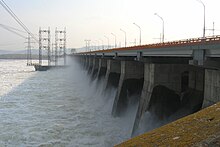
Hydroelectricity, or hydroelectric power, is electricity generated from hydropower. Hydropower supplies one sixth of the world's electricity, almost 4500 TWh in 2020, which is more than all other renewable sources combined and also more than nuclear power. Hydropower can provide large amounts of low-carbon electricity on demand, making it a key element for creating secure and clean electricity supply systems. A hydroelectric power station that has a dam and reservoir is a flexible source, since the amount of electricity produced can be increased or decreased in seconds or minutes in response to varying electricity demand. Once a hydroelectric complex is constructed, it produces no direct waste, and almost always emits considerably less greenhouse gas than fossil fuel-powered energy plants. However, when constructed in lowland rainforest areas, where part of the forest is inundated, substantial amounts of greenhouse gases may be emitted.
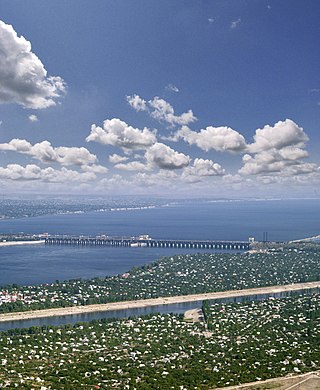
The Volga Hydroelectric Station or Volga GES also known as the 22nd Congress of the CPSU Stalingrad/Volgograd Hydroelectric Power Station, is the largest hydroelectric station in Europe, and it is the last of the Volga-Kama Cascade of dams, immediately before the Volga River flows into the Caspian Sea. It was the largest powerstation in the world between 1960 and 1963. Today, it is operated by the electricity company RusHydro.
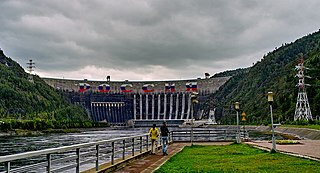
The Sayano-Shushenskaya Dam is located on the Yenisei River, near Sayanogorsk in Khakassia, Russia. It is the largest power plant in Russia and the 9th-largest hydroelectric plant in the world, by average power generation. The full legal name of the power plant, OJSC [Open Joint-Stock Society] P. S. Neporozhny Sayano-Shushenskaya HPP [hydro power plant], refers to the Soviet-time Minister of Energy and Electrification Pyotr Neporozhny. As of 2009 the head of the power plant was Valery Kyari.
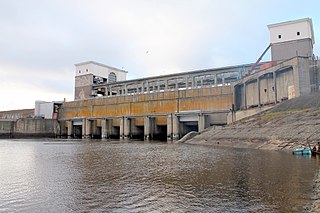
Rybinsk Hydroelectric Station or Rybinsk GES is a hydroelectric station on the Volga and the Sheksna rivers in Yaroslavl Oblast near the Rybinsk town. it is the third of the Volga-Kama Cascade of dams.
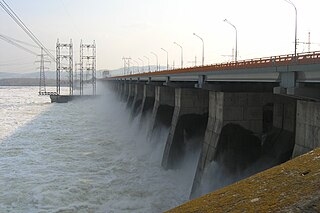
The Zhiguli Hydroelectric Station or Zhigulyovskaya Hydroelectric Station, formerly known as Kuybyshev Hydroelectric Station is a large dam and hydroelectric station on the Volga River, located near Zhigulyovsk and Tolyatti in Samara Oblast of Russia. It is the sixth stage of the Volga-Kama Cascade of dams, and the second of them by installed power.

RusHydro is a Russian hydroelectricity company. As of early 2012 it had a capacity of 34.9 gigawatts. In late 2009, it was the world's second-largest hydroelectric power producer and is the country's largest power-generating company and the largest successor to RAO UES. The conglomerate, which is partly government-owned, underwent a major consolidation beginning in July 2007. As of 2011, the head of the company was Evgeny Dod. Its head office is in Obruchevsky District, South-Western Administrative Okrug, Moscow.

The Kambar-Ata-2 Hydro Power Plant is a hydroelectric power station on the river Naryn near Kara-Jygach, Toktogul District, Kyrgyzstan. When completed, it will have 3 individual Francis turbine-generators with a nominal output of around 120 MW each which will deliver up to 360 MW of power. The first generator was operational on November 27, 2010. The power plant's dam is 60 m (197 ft) tall and it creates a 70,000,000 m3 (56,750 acre⋅ft) reservoir of which 8,000,000 m3 (6,486 acre⋅ft) is active for power generation.
The Kambar-Ata Dam is a proposed dam on the Naryn River in central Kyrgyzstan. One of six planned to be built on the river, it will become one of the largest dams in the world at approximately 275 metres (902 ft) high and containing about 370 million cubic metres of rock and earth. The Kambar-Ati-1 Hydro Power Plant at the base of the dam will have a capacity of around 2,000 megawatts. The project will be constructed jointly with Russia and possibly Kazakhstan as well.

The Boguchany Dam is a large hydroelectric dam on the Angara River in Kodinsk, Krasnoyarsk Krai, Russia. It has an installed capacity of 2,997 MW. Construction of the power plant was completed when a ninth and final generator was brought online in January 2015.

On 17 August 2009, a turbine at the hydroelectric power station of the Sayano-Shushenskaya Dam near Sayanogorsk in Russia failed catastrophically, flooding the turbine hall and killing 75 people. A section of the roof of the turbine hall collapsed; all but one of the ten turbines were damaged or destroyed. The entire plant output, totalling 6,400 megawatts (MW) – a significant portion of the supply to the local area – was lost, leading to widespread power outages. An official report on the accident was released in October 2009.
Lenhydroproject is a major research and design institute for hydrotechnology and hydroelectric engineering based in St. Petersburg, Russia. Since 1993 it is incorporated as a "JSC Lenhydroproject", part of RusHydro company.
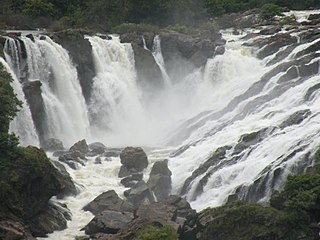
India is 5th globally for installed hydroelectric power capacity. As of 31 March 2020, India's installed utility-scale hydroelectric capacity was 46,000 MW, or 12.3% of its total utility power generation capacity. Additional smaller hydroelectric power units with a total capacity of 4,683 MW have been installed. India's hydroelectric power potential is estimated at 148,700 MW at 60% load factor. In the fiscal year 2019–20, the total hydroelectric power generated in India was 156 TWh with an average capacity factor of 38.71%.
The Zeya Dam is a concrete gravity dam on the Zeya River by the town of Zeya, Amur Oblast, Russia, north of the Chinese border. On average the Zeya Hydroelectric Power Station generates 4.91 TWh of electricity per year. It is equipped with 6 hydro-turbines, 4 with capacity of 225 MW and 2 with capacity of 215 MW.

Renewable energy in Russia mainly consists of hydroelectric energy. In 2010, the country was the sixth largest producer of renewable energy in the world, although it was 56th when hydroelectric energy was not taken into account. Some 179 TWh of Russia's energy production came from renewable energy sources, out of a total economically feasible potential of 1823 TWh. 16% of Russia's electricity was generated from hydropower, and less than 1% was generated from all other renewable energy sources combined. Roughly 68% of Russia's electricity was generated from thermal power and 16% from nuclear power.

The Uglich Hydroelectric Station or Uglich GES is a hydroelectric station on the Volga River in Uglich in Yaroslavl Oblast, Russia, and is the first of the Volga-Kama Cascade of dams. It began operating on December 8, 1940, making it one of the oldest hydroelectric plants in Russia. The plant has a 120 MW capacity and is operated by RusHydro. There is also a Russian hydropower museum located at the hydroelectric plant dedicated to the development of hydropower.
The Alpaslan-2 Dam is an embankment dam on the Murat River in Muş Province, Turkey. The dam is located about 32 km (20 mi) north of the provincial capital, Muş. The primary purpose of the dam is hydroelectric power production and irrigation. Its power station has an installed capacity of 280 MW, planning to deliver 850 GWh annually, and the reservoir will help irrigate 78,000 ha of land.

Hydroelectricity is currently China's largest renewable energy source and the second overall after coal. China's installed hydroelectric capacity in 2015 was 356 GW, up from 172 GW in 2009, including 23 GW of pumped storage hydroelectricity capacity. According to the International Hydropower Association China is the worlds largest producer of hydroelectricity in 2021. In 2018, hydropower generated 1,232 TWh of power, accounting for roughly 18% of China's total electricity generation.
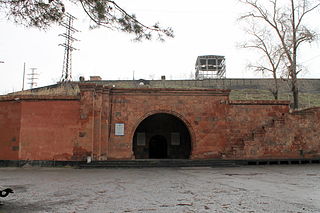
Sevan–Hrazdan Cascade is a complex of hydroelectric power plants on the Hrazdan River and its tributaries between the Lake Sevan and Yerevan in Armenia. They use irrigation water flow from the Lake Sevan and streams waters of Hrazdan River. The cascade is owned by the International Energy Corporation (IEC), a subsidiary of Tashir Group owned by Samvel Karapetyan.
Evgeny Vyacheslavovich Dod is a Russian manager and economist. He is CEO of JSC RusHydro.
